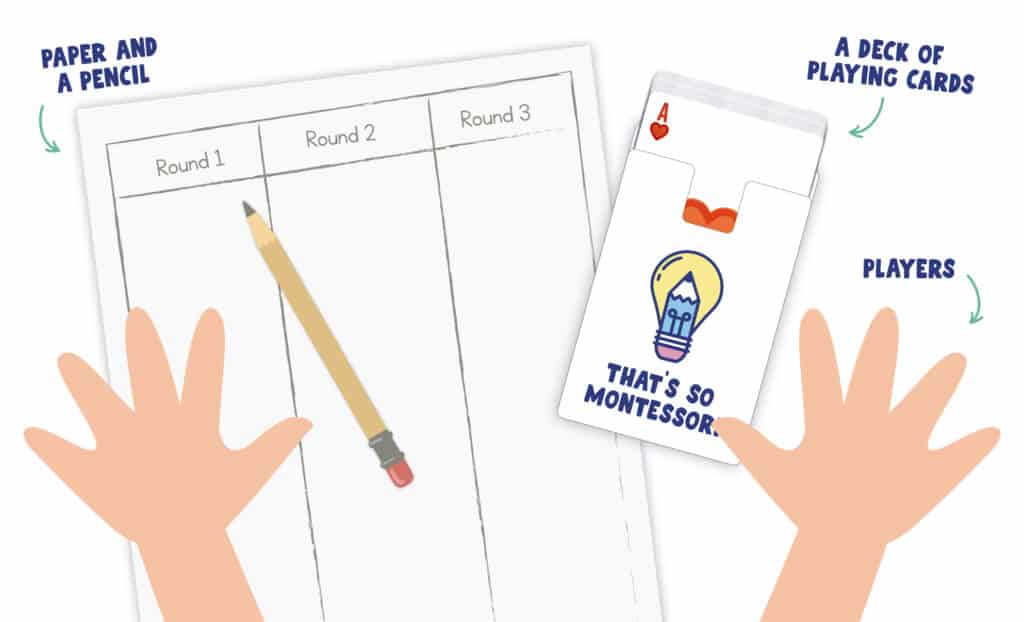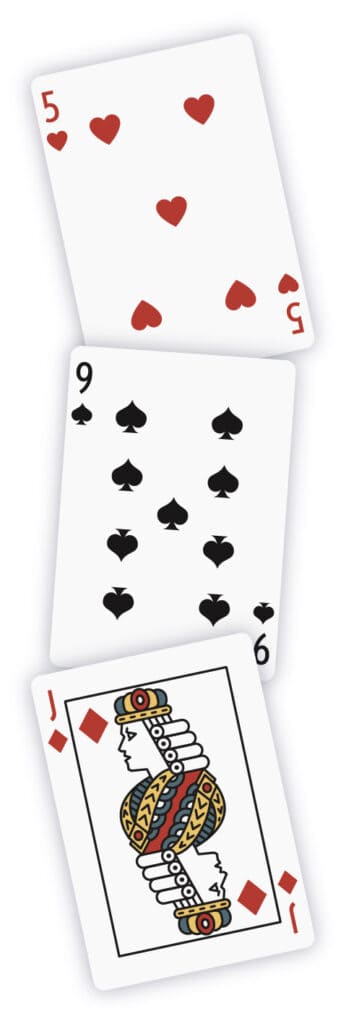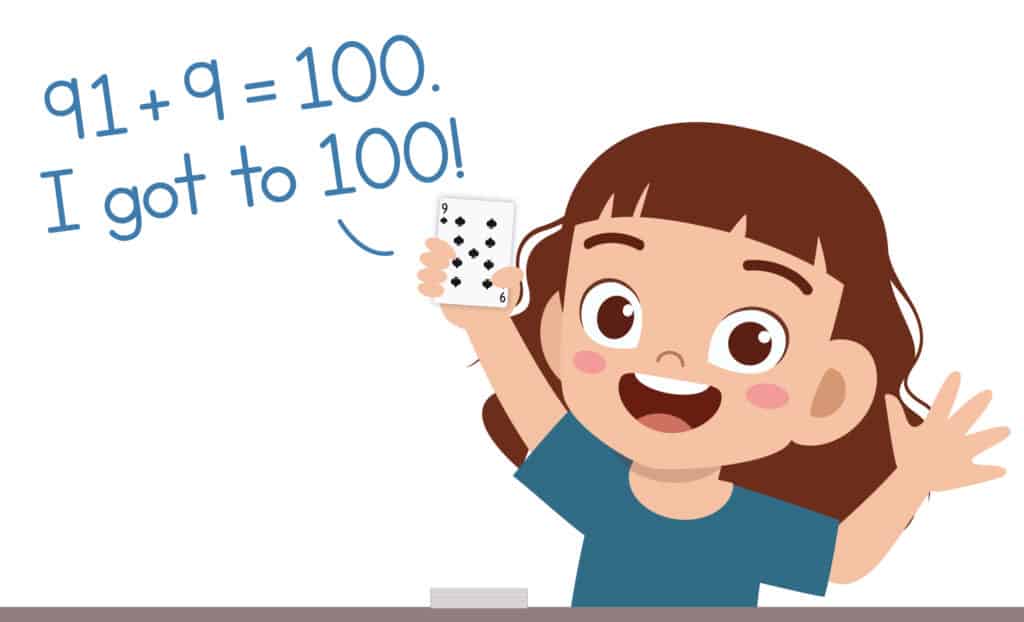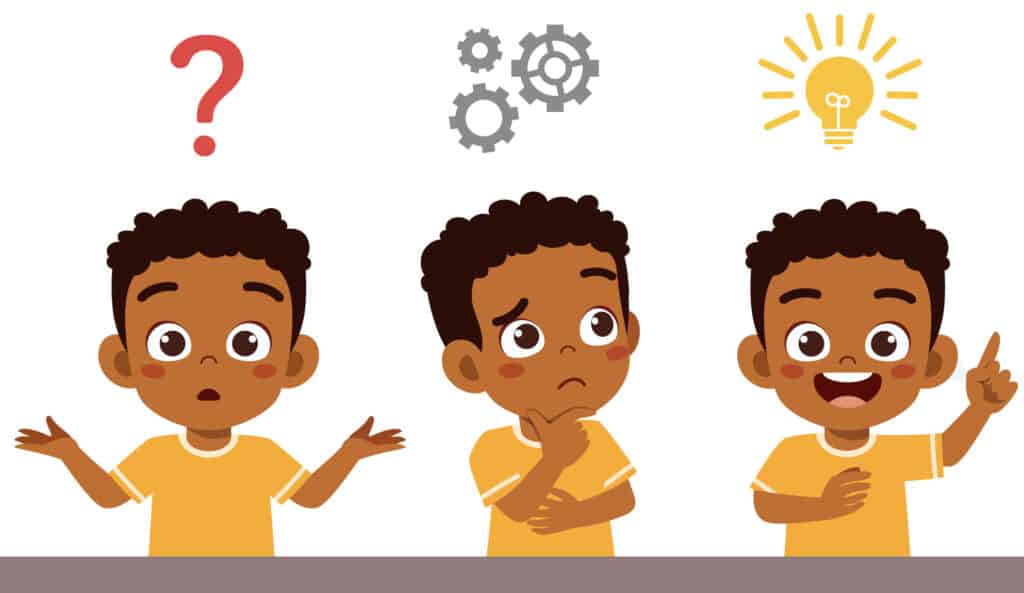Elevate Elementary Math Skills with This Exciting Math Card Game
Looking for a fun way to improve elementary math skills? Check out this captivating math card game, tailored to boost addition skills up to 100.
Used frequently in my elementary Montessori classroom, this game isn’t your usual math practice. By mixing card fun with math, it makes learning exciting and gives a fresh alternative to boring worksheets.
Math Card Game: Flip and Add to 100
This is a simple math card game that helps students solidify their addition skills.
What You Need:
🃏 A deck of playing cards
✏️ Paper and pencil for each player
👥 2 or more players (but can be played solo!)

Deck Set-Up:
Make it easier for your students by removing the face cards.
OR
Make it more challenging by using these values for face cards:
Jack = 11
Queen = 12
King = 13
Ace = 0
Jokers = player’s choice – choose any number from 1 to 10
How To Play This Math Card Game With Two or More Players:
➊ Decide if you’re going to play using the face cards or not. Remove the face cards if you don’t plan to use them.
➋ Start the game by stacking the whole deck of cards in the middle of the playing area.
➌ On their turn, players pick up one card from the top of the pile and write that number down on their paper. That pulled playing card is then placed at the bottom of the card stack.
➍ Players add each card they pull to the running sum they have on their paper.
🏆 The first person to get to exactly 100 wins (or the closest person to 100 without going over or the first player to pass 100, whatever works for you!).
For Example:
If one student pulls a 5 in the first round and then a 9 in the second round they add those numbers together to get a score of 14. On the third round if they pull a Jack they need to add 11 to the previous sum of 14, making their new total 25.
That’s one-quarter of the way to 100. Almost there!

Only Have 1 Player?
No problem! This game is great for solo learning!
Different Ways To Play This Math Card Game With Only One Player:
➊ Have the student play multiple rounds within a specified time frame using a timer and have them try to add to 100 as fast as possible. Have them keep track of the amount of time it took them to get to 100 each round.
➋ Have players see how big a sum they can add up to in a specified amount of time. I like to use small increments of playing time such as 90 seconds to 3 minutes.
➌ Have students see how close they can get to a sum of 100 in one minute. After one minute, they need to find the difference between their sum and one hundred, just to squeeze in some subtraction practice!
Yay for independent educational play!

Make it even more challenging!
✂️ Split the deck (or use one deck of cards per player if you have multiple decks on hand) so that students have the same number of cards.
⏱️ Using a timer, have students race one another to see who can add up to 100 first by flipping and adding the numbers from their respective decks.
Take it up another level!
🧠 Make it mental math! Challenge players to use their memory as opposed to paper and pencil to keep track of their sum. That’s right! Get students to keep their running total in their head and add to it each number flipped in each round.
✖ Multiply the fun! In this version, you’ll want to remove the face cards (jack, queen, king) but keep the Joker as a wild card. Have students pull two cards from the top of the deck, multiply them together, and record the product. In this game mode, players will add the products of each round together in hopes of being the first to reach the goal of 100. Since multiplication is being used, there is potential for some big numbers, so you may want to change the end goal number to 200 or even 500!
Now that’s a challenge!
Everyone needs a little addition practice every now and again, so why not find sums with some fun? We love this game because it’s enjoyable and adaptable for all ages and skill levels.
Fun stuff, right? And purposeful, too!
This is exactly why math games are a staple in my upper elementary classroom. Students truly do benefit from playing games in the classroom.
💡 Looking for more educational math games?
Be sure to read these blogs:
21 Fun Math Games with Dice to Try With Kids 8-12
15 Educational Games With Three Dice for Kids
9 Montessori-Aligned Math Activities for Elementary Students
Benefits of This Math Card Game
This math card game offers several benefits for students. Here are just a few:
💪🏽 Reinforces Addition Skills
By constantly adding numbers as they flip cards, students get a lot of practice and develop fluency in addition.
🛠️ Builds Number Sense
As students repeatedly encounter different combinations of numbers to reach 100, they develop a deeper understanding of number relationships and patterns.
🌟 Enhances Mental Math Abilities
The fast-paced nature of the game encourages students to mentally calculate and add numbers quickly. This enhances their mental math abilities, improving their speed, accuracy, and overall computational skills.

💥 Increases Engagement and Motivation
By incorporating elements of play and competition, students are more likely to actively participate and enjoy the learning process.
😎 Adaptable to Different Skill Levels
This math card game can be adapted to accommodate different skill levels so everyone can enjoy this activity.
Incorporating this math card game into your learning plan brings a myriad of benefits. It not only strengthens addition skills but also enhances mental math abilities and fosters a positive attitude toward mathematics.
➕ Find Montessori command cards for addition here!
Check out all of our math command cards, too.
Want to know why they are great?
Read our blog Elevate Your Math Game: 9 Perks Of Montessori Command Cards.
The Wrap-Up: Elevate Elementary Math Skills with This Math Card Game
Incorporating a math card game to improve a student’s addition skills into your math lessons or family game nights is a fantastic way to make math practice enjoyable and effective.
As students engage in friendly competition, they develop essential math skills, boost their mental math abilities, and gain confidence in tackling addition problems.
Whether you’re a teacher seeking an engaging classroom activity for the end of the school year or a parent looking for a fun way to support your child’s learning at home, this math card game is a must-try option.
Now it’s time to play! Gather a deck of cards and let the learning in disguise begin with this exciting and educational math card game!
Keep your kids busy learning with the educational activities in these blogs:
11 Ways to Use Our Roll A Story Dice Game
13 Engaging Vocabulary Development Activities for Elementary Kids
Rebus Puzzles for Kids: A Comprehensive Riddle-Solving Guide
31 Fun Summer Reading Activities Elementary Students Will Love
The Best Neighborhood Walk Scavenger Hunt and 13 Different Ways to Use It
8 Easy Rebus Puzzles with Answers
27 Educational YouTube Channels to Prevent Summer Learning Loss
Try These Fun Math Products With Your Elementary Kids:
Math Fact Dice Game Addition and Division Practice
Math Jokes for Kids and Teachers
Digital Math Games Lesson with Worksheets
Crypto-Riddles Math Fact Practice
Order of Operations Task Cards with Answers + Anchor Chart
Distributive Law of Multiplication Command Cards with Answers + Anchor Chart


